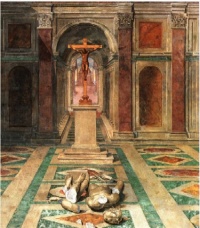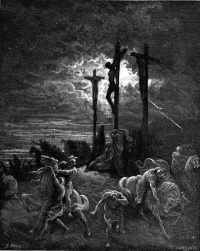Bible
From The Art and Popular Culture Encyclopedia

|
"It is not too much, then, to claim for the Bible, that, as a classic, it stands without a rival at the head of all human literature. It is not too much to say, that it has eventually controlled and impregnated, with its own immortal spirit, the literature of every people, into whose vernacular it has been translated. And at this moment, there is not, perhaps, in the whole world of letters, a more important and effective work going forward, than that work of translation, which, under the silent but sublime labors of the missionary, is making the Bible a classic book in every human tongue."--The Literary Attractions of the Bible (1858) by Leroy J. Halsey "Does the Bible come within the ruling of the Lord Chief Justice as to obscene literature? Most decidedly it does, and if prosecuted as an obscene book, it must necessarily be condemned, if the law is justly administered." --"Is the Bible Indictable?" (c. 1877) by Annie Besant "Somebody ought to tell the truth about the Bible. The preachers dare not, because they would be driven from their pulpits. Professors in colleges dare not, because they would lose their salaries. Politicians dare not. They would be defeated. Editors dare not. They would lose subscribers. Merchants dare not, because they might lose customers. Men of fashion dare not, fearing that they would lose caste. Even clerks dare not, because they might be discharged. And so I thought I would do it myself."--About the Holy Bible (1894) by Robert G. Ingersoll |
|
Related e |
|
Featured: |
The Bible (from Koine Greek τὰ βιβλία, tà biblía, 'the books') is a collection of religious texts or scriptures, some, all, or a variant of which, are held to be sacred in Christianity, Judaism, Samaritanism, Islam, Baha'i'ism and many other religions. The Bible is an anthology, a compilation of texts of a variety of forms, originally written in Hebrew, Aramaic, and Koine Greek. These texts include instructions, stories, poetry, and prophecies, and other genres. The collection of materials that are accepted as part of the Bible by a particular religious tradition or community is called a biblical canon. Believers in the Bible generally consider it to be a product of divine inspiration, but the way they understand what that means and interpret the text varies.
The religious texts were compiled by different religious communities into various official collections. The earliest contained the first five books of the Bible. It is called the Torah in Hebrew and the Pentateuch (meaning five books) in Greek; the second oldest part was a collection of narrative histories and prophecies (the Nevi'im); the third collection (the Ketuvim) contains psalms, proverbs, and narrative histories. "Tanakh" is an alternate term for the Hebrew Bible composed of the first letters of those three parts of the Hebrew scriptures: the Torah ("Teaching"), the Nevi'im ("Prophets"), and the Ketuvim ("Writings"). The Masoretic Text is the medieval version of the Tanakh, in Hebrew and Aramaic, that is considered the authoritative text of the Hebrew Bible by modern Rabbinic Judaism. The Septuagint is a Koine Greek translation of the Tanakh from the third and second centuries BC; it largely overlaps with the Hebrew Bible.
Christianity began as an outgrowth of Second Temple Judaism, using the Septuagint as the basis of the Old Testament. The early Church continued the Jewish tradition of writing and incorporating what it saw as inspired, authoritative religious books. The gospels, Pauline epistles, and other texts quickly coalesced into the New Testament.
With estimated total sales of over five billion copies, the Bible is the best-selling publication of all time. It has had a profound influence both on Western culture and history and on cultures around the globe. The study of it through biblical criticism has indirectly impacted culture and history as well. The Bible is currently translated or is being translated into about half of the world's languages.
Etymology
From Latin biblia, a collection of books (since there are many books in the Bible), eventually from the ancient Phoenician city of Byblos which exported this writing material.
Literature and the arts
|
"As formerly [painters] had searched through classic authors, so now they searched through the Bible for erotic scenes; and what they found there was not as harmless as the joyous legends of the Hellenes, but such scenes as Lot and his daughters, the expulsion of Hagar, the two elders peeping at Susanna in the bath, or Herodias confounding by her dance the senses of old Herod. If Judith is represented with especial frequency as the murderess of Holofernes, the reason probably is that the thought was akin to the episode of Beatrice Cenci."--The History of Painting: From the Fourth to the Early Nineteenth Century (1893/94) by Richard Muther |
The Bible has directly and indirectly influenced literature and art. In the republic of letters, there is St Augustine's Confessions, the Summa Theologica and Dante's Divine Comedy.
Many masterpieces of Western art were inspired by biblical themes: from Michelangelo's David and Pietà sculptures, to Leonardo da Vinci's Last Supper and Raphael's various Madonna paintings. There are hundreds of examples. Eve, the temptress who disobeys God's commandment, is probably the most widely portrayed figure in art.
See also
- Biblia pauperum
- Biblical art
- Biblical eroticism
- Biblical inerrancy
- Biblical stories
- Gustave Doré's illustrations for La Grande Bible de Tours (1865)
- Christian art
- Illustrated bible
- Gutenberg Bible
- Religious text
- Wisdom literature


